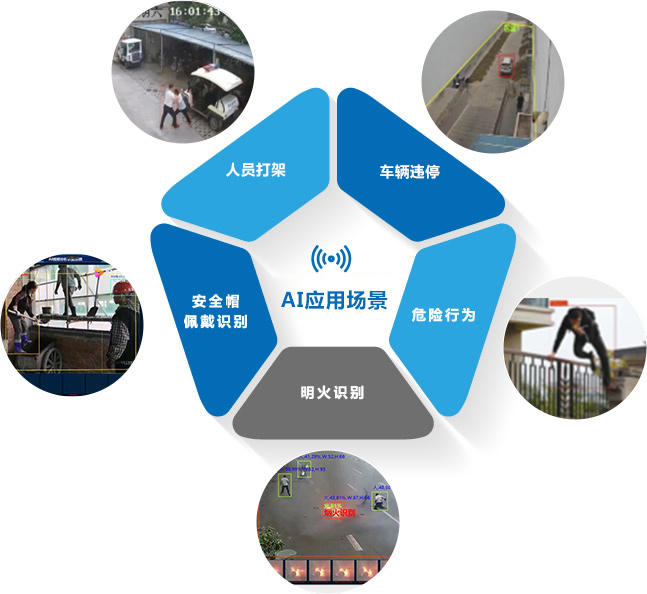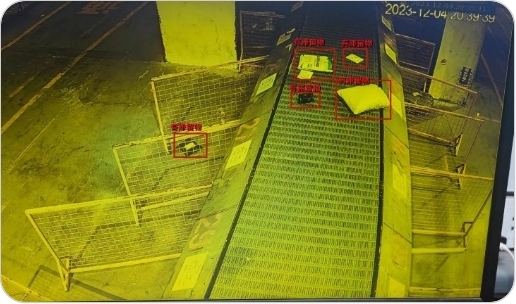Logistics giants' new weapon: AI empowers traditional monitoring to achieve intelligent transition
A Fortune 500 logistics group, as a leader in the global logistics industry, ranks second in the world in terms of sea freight forwarding, first in Asia, and fifth in the world in terms of air freight forwarding. Driven by the digital wave, the group actively embraces technological changes, starting from fire and security systems, injecting intelligent genes into traditional monitoring systems through the introduction of AI vision technology, and taking an important step towards upgrading security management intelligence.
The goal of this project is not only to upgrade the monitoring system, but also to create a safe and efficient intelligent logistics park management model through the new ability of "perception, recognition, and decision-making".
Pain points and AI solutions
The five major pain points of traditional monitoring:
1. Data processing relies on manual labor, resulting in low efficiency
Traditional monitoring generates massive amounts of data every day, and manual review and analysis are inefficient and prone to missed reports.
2. Unable to proactively alert
Unable to identify abnormal behavior in real-time, usually only recorded without alerting.
3. Insufficient business insights
Traditional monitoring devices are unable to generate data that can be used to optimize decision-making.
4. High pressure on data storage
Long term video recording consumes a lot of bandwidth and storage space.
5. High upgrade cost
Replacing existing equipment and increasing storage costs a significant budget.
Intelligent solutions for AI
1. No camera replacement, low-cost upgrade
Commonly used and mainstream high-definition cameras can meet the upgrade requirements, and upgrading can be easily achieved by using a server adapted to the algorithm.
2. Data intelligent analysis: Based on existing cameras, real-time data analysis and key event recognition are achieved in seconds through 50 standard algorithms and customized models.
3. Scenario based warning: Identify events such as intrusion, unauthorized parking, and abnormal behavior, and actively trigger alarms.
4. Dynamic control capability: Through scene recognition, target tracking and monitoring strategies can be dynamically adjusted.
5. Deep learning closed-loop optimization: AI cameras continuously improve recognition accuracy and reliability by learning on-site data.
This is the closed-loop application of algorithms, models, integrated engineering, and deep relearning, which is the condensation of Weida technology and practice.
Specific Implementation and Achievements
The first phase of the project will be launched simultaneously in Qingdao and Chengdu, with a construction period of only one month, achieving seamless integration with the daily operation of the park. The Beijing headquarters accesses national data in real-time through the central management platform to ensure full coverage of security management.
Due to the lack of replacement of existing equipment, there is no need for construction, so the entire implementation process does not affect the use and operation of the enterprise.
Highlights of Achievements
1. We did not replace the original camera and added algorithms on the server side to achieve the lowest cost upgrade.
2. The recognition rate has been increased to over 96%, the false alarm rate has been reduced to 4%, and the false alarm rate is close to 0, and it is continuously being optimized.
3. The alarm response time has been shortened from the traditional hourly calculation to a maximum of 3 minutes, significantly improving safety efficiency.
4. The system supports multi-dimensional alarm information synchronization, and the transparency of monthly report generation and analysis is higher.
Actual case:
1. In an emergency incident in the Chengdu campus, AI cameras identified invading vehicles in real-time and quickly triggered an alarm. The security team completed the interception in just 3 minutes, successfully avoiding a potential security incident.
Customer review: "The AI system is not just a monitoring device, but more like a 24/7 security manager. ”
2. In a potential spontaneous combustion event in a transport trailer, the AI camera uses smoke detection function to identify abnormal situations in the first time and trigger an alarm. The management team responded quickly and extinguished the small flames, avoiding potential significant property damage.
Customer review: "The precise recognition and instant alarm of AI cameras saved us from a possible major property loss, and the effect far exceeded traditional monitoring equipment. ”
3. For monitoring the operational status of large equipment (such as manual/automatic mode), traditional methods often require deep integration and complex configuration in the background. And AI cameras directly obtain device status through visual recognition, without the need for additional hardware or cumbersome settings, greatly reducing time and labor costs, while improving management efficiency.
Customer review: "This technological advancement gives us confidence in digital transformation, and we hope to explore more AI applications in the future

Multi needle reading recognition
Industry Applications and Future Sharing Plan
Weida's AI vision algorithm has been widely applied in multiple industry scenarios:
● Smart security: personnel density, identification of male entering female dormitories, identification of multiple fights, missing identification, identification of rooftop personnel, identification of special actions seeking help, identification of dangerous area intrusion, identification of dangerous behaviors, crowd gathering, armed and other risky behaviors. Wire intrusion, area intrusion, smoke and fire detection, electric vehicle detection, garbage detection, wall crossing detection, boundary crossing detection, flame detection, nighttime intrusion, camera abnormal displacement detection, fall detection, gesture alarm, entrance and exit personnel statistics, oil unloading time, fire extinguisher recognition

AI application scenarios

Identification of retained materials
● Smart transportation: vehicle violation detection, license plate recognition, traffic flow optimization, empowering urban transportation, vehicle type recognition, vehicle attribute recognition, tricycle attribute recognition, manhole cover recognition, charging pile occupancy recognition, red light running recognition, helmet not wearing recognition, seatbelt not wearing recognition, road congestion recognition, vehicle occupying recognition, vehicle speeding recognition
● Smart Retail: Analyze customer behavior, collect customer flow data, help optimize store layout, and enhance customer experience.
● Smart industrial production: Real time monitoring of equipment operation status, detection and early warning of faults, improving production efficiency and safety.
●Embodied Robot Vision Module: Empowering robots with perception and recognition capabilities through "stronger eyes", opening up more scenario based applications.
● Intelligent management of the the Belt and Road project: use intelligent means to solve management problems caused by cultural language.
In the future, Vietadata will continue to break through technological boundaries and empower intelligent transformation for more industries. Stay tuned for our next story!









